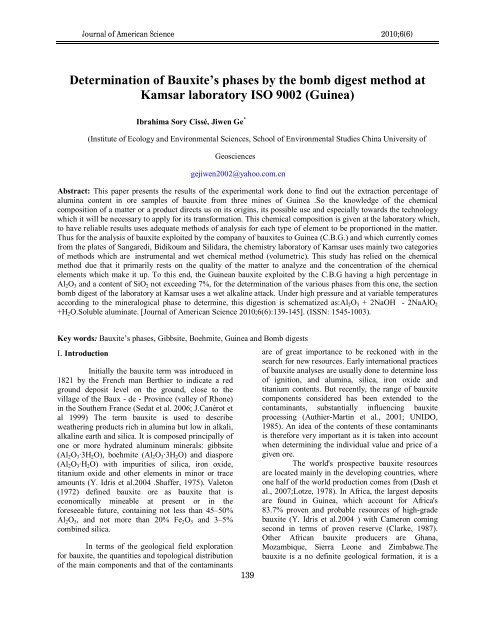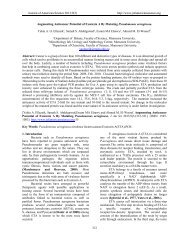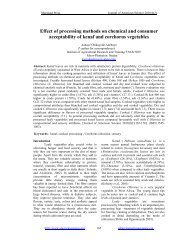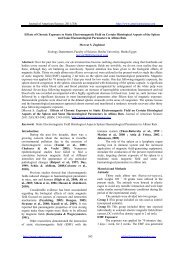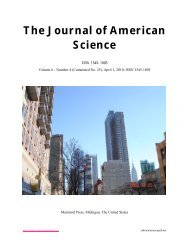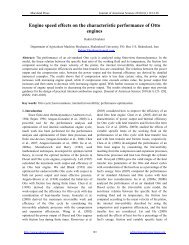Determination of Bauxite's phases by the bomb digest method at ...
Determination of Bauxite's phases by the bomb digest method at ...
Determination of Bauxite's phases by the bomb digest method at ...
You also want an ePaper? Increase the reach of your titles
YUMPU automatically turns print PDFs into web optimized ePapers that Google loves.
Journal <strong>of</strong> American Science 2010;6(6)<br />
<strong>Determin<strong>at</strong>ion</strong> <strong>of</strong> Bauxite’s <strong>phases</strong> <strong>by</strong> <strong>the</strong> <strong>bomb</strong> <strong>digest</strong> <strong>method</strong> <strong>at</strong><br />
Kamsar labor<strong>at</strong>ory ISO 9002 (Guinea)<br />
Ibrahima Sory Cissé, Jiwen Ge *<br />
(Institute <strong>of</strong> Ecology and Environmental Sciences, School <strong>of</strong> Environmental Studies China University <strong>of</strong><br />
Geosciences<br />
gejiwen2002@yahoo.com.cn<br />
Abstract: This paper presents <strong>the</strong> results <strong>of</strong> <strong>the</strong> experimental work done to find out <strong>the</strong> extraction percentage <strong>of</strong><br />
alumina content in ore samples <strong>of</strong> bauxite from three mines <strong>of</strong> Guinea .So <strong>the</strong> knowledge <strong>of</strong> <strong>the</strong> chemical<br />
composition <strong>of</strong> a m<strong>at</strong>ter or a product directs us on its origins, its possible use and especially towards <strong>the</strong> technology<br />
which it will be necessary to apply for its transform<strong>at</strong>ion. This chemical composition is given <strong>at</strong> <strong>the</strong> labor<strong>at</strong>ory which,<br />
to have reliable results uses adequ<strong>at</strong>e <strong>method</strong>s <strong>of</strong> analysis for each type <strong>of</strong> element to be proportioned in <strong>the</strong> m<strong>at</strong>ter.<br />
Thus for <strong>the</strong> analysis <strong>of</strong> bauxite exploited <strong>by</strong> <strong>the</strong> company <strong>of</strong> bauxites to Guinea (C.B.G.) and which currently comes<br />
from <strong>the</strong> pl<strong>at</strong>es <strong>of</strong> Sangaredi, Bidikoum and Silidara, <strong>the</strong> chemistry labor<strong>at</strong>ory <strong>of</strong> Kamsar uses mainly two c<strong>at</strong>egories<br />
<strong>of</strong> <strong>method</strong>s which are instrumental and wet chemical <strong>method</strong> (volumetric). This study has relied on <strong>the</strong> chemical<br />
<strong>method</strong> due th<strong>at</strong> it primarily rests on <strong>the</strong> quality <strong>of</strong> <strong>the</strong> m<strong>at</strong>ter to analyze and <strong>the</strong> concentr<strong>at</strong>ion <strong>of</strong> <strong>the</strong> chemical<br />
elements which make it up. To this end, <strong>the</strong> Guinean bauxite exploited <strong>by</strong> <strong>the</strong> C.B.G having a high percentage in<br />
Al2O3 and a content <strong>of</strong> SiO2 not exceeding 7%, for <strong>the</strong> determin<strong>at</strong>ion <strong>of</strong> <strong>the</strong> various <strong>phases</strong> from this one, <strong>the</strong> section<br />
<strong>bomb</strong> <strong>digest</strong> <strong>of</strong> <strong>the</strong> labor<strong>at</strong>ory <strong>at</strong> Kamsar uses a wet alkaline <strong>at</strong>tack. Under high pressure and <strong>at</strong> variable temper<strong>at</strong>ures<br />
according to <strong>the</strong> mineralogical phase to determine, this <strong>digest</strong>ion is schem<strong>at</strong>ized as:Al2O3 + 2NaOH - 2NaAlO2<br />
+H2O.Soluble alumin<strong>at</strong>e. [Journal <strong>of</strong> American Science 2010;6(6):139-145]. (ISSN: 1545-1003).<br />
Key words: Bauxite’s <strong>phases</strong>, Gibbsite, Boehmite, Guinea and Bomb <strong>digest</strong>s<br />
I. Introduction<br />
are <strong>of</strong> gre<strong>at</strong> importance to be reckoned with in <strong>the</strong><br />
search for new resources. Early intern<strong>at</strong>ional practices<br />
Initially <strong>the</strong> bauxite term was introduced in <strong>of</strong> bauxite analyses are usually done to determine loss<br />
1821 <strong>by</strong> <strong>the</strong> French man Berthier to indic<strong>at</strong>e a red <strong>of</strong> ignition, and alumina, silica, iron oxide and<br />
ground deposit level on <strong>the</strong> ground, close to <strong>the</strong> titanium contents. But recently, <strong>the</strong> range <strong>of</strong> bauxite<br />
village <strong>of</strong> <strong>the</strong> Baux - de - Province (valley <strong>of</strong> Rhone) components considered has been extended to <strong>the</strong><br />
in <strong>the</strong> Sou<strong>the</strong>rn France (Sed<strong>at</strong> et al. 2006; J.Canérot et contaminants, substantially influencing bauxite<br />
al 1999) The term bauxite is used to describe processing (Authier-Martin et al., 2001; UNIDO,<br />
wea<strong>the</strong>ring products rich in alumina but low in alkali, 1985). An idea <strong>of</strong> <strong>the</strong> contents <strong>of</strong> <strong>the</strong>se contaminants<br />
alkaline earth and silica. It is composed principally <strong>of</strong> is <strong>the</strong>refore very important as it is taken into account<br />
one or more hydr<strong>at</strong>ed aluminum minerals: gibbsite when determining <strong>the</strong> individual value and price <strong>of</strong> a<br />
(Al2O3·3H2O), boehmite (Al2O3·3H2O) and diaspore given ore.<br />
(Al2O3·H2O) with impurities <strong>of</strong> silica, iron oxide,<br />
The world's prospective bauxite resources<br />
titanium oxide and o<strong>the</strong>r elements in minor or trace are loc<strong>at</strong>ed mainly in <strong>the</strong> developing countries, where<br />
amounts (Y. Idris et al.2004 .Shaffer, 1975). Valeton one half <strong>of</strong> <strong>the</strong> world production comes from (Dash et<br />
(1972) defined bauxite ore as bauxite th<strong>at</strong> is al., 2007;Lotze, 1978). In Africa, <strong>the</strong> largest deposits<br />
economically mineable <strong>at</strong> present or in <strong>the</strong> are found in Guinea, which account for Africa's<br />
foreseeable future, containing not less than 45–50% 83.7% proven and probable resources <strong>of</strong> high-grade<br />
Al2O3, and not more than 20% Fe2O3 and 3–5% bauxite (Y. Idris et al.2004 ) with Cameron coming<br />
combined silica.<br />
second in terms <strong>of</strong> proven reserve (Clarke, 1987).<br />
O<strong>the</strong>r African bauxite producers are Ghana,<br />
In terms <strong>of</strong> <strong>the</strong> geological field explor<strong>at</strong>ion Mozambique, Sierra Leone and Zimbabwe.The<br />
for bauxite, <strong>the</strong> quantities and topological distribution<br />
<strong>of</strong> <strong>the</strong> main components and th<strong>at</strong> <strong>of</strong> <strong>the</strong> contaminants<br />
bauxite is a no definite geological form<strong>at</strong>ion, it is a<br />
139
Journal <strong>of</strong> American Science 2010;6(6)<br />
mixture <strong>of</strong> oxides whose aluminum oxide is far more<br />
domin<strong>at</strong>ing, <strong>the</strong>n comes <strong>the</strong> iron oxide which gives<br />
<strong>the</strong> reddish color to bauxite, <strong>the</strong> silica oxide and some<br />
compounds from metals such as: vanadium, titanium,<br />
lead, calcium, Zinc. Sometimes sulphur, copper,<br />
Nickel ,according <strong>by</strong> M.Karadag et al 2009.<br />
The composition <strong>of</strong> bauxites generally varies in <strong>the</strong><br />
following percentages (Santos et al 2004):<br />
AL2O3 40-60%;H2O 12-30%;Fe2O3 5-30%;<br />
SiO2 1-20%<br />
The bauxites quality initially depends on<br />
<strong>the</strong>ir content <strong>of</strong> Al2O3 and SiO2. The more <strong>the</strong><br />
bauxites contain Al2O3 and less SiO2, <strong>the</strong> higher <strong>the</strong>ir<br />
economic and industrial values are significant (Tardy<br />
et al. 1991).<br />
In Kamsar, it is <strong>the</strong> trihydr<strong>at</strong>e which is most<br />
widespread whose characteristics make this bauxite<br />
most economically exploited. It is most soluble in<br />
alkalis and dissolves between 90 <strong>at</strong> 100 C. It comes in<br />
II - Properties <strong>of</strong> alumina hydr<strong>at</strong>es<br />
The properties <strong>of</strong> alumina hydr<strong>at</strong>e (A. Asghar Calagari, 2007) as fallowing<br />
Table 1.The Properties <strong>of</strong> alumina hydr<strong>at</strong>es<br />
140<br />
general from <strong>the</strong> deterior<strong>at</strong>ion <strong>of</strong> <strong>the</strong> sediments (schist,<br />
aleurolo<strong>the</strong>s, argillites) and basic magm<strong>at</strong>ic rocks<br />
(dolerites, gabbro-dolerites, konga-diabase) (Luke J.<br />
Kirwan 2009).<br />
The bauxite <strong>of</strong> Guinea exploited <strong>by</strong> <strong>the</strong><br />
CBG is in <strong>the</strong> open air very rich in alumina and a<br />
content <strong>of</strong> SiO2 lower than 7 %( Santos M.C, 2003).<br />
For bauxites rich in Al2 O3 and low SiO2, <strong>the</strong> wet<br />
alkaline process is best according <strong>by</strong> N. Zwingmann<br />
et al 2009 .The purpose <strong>of</strong> this study <strong>the</strong>refore is to<br />
ascertain <strong>the</strong> quality and <strong>the</strong> n<strong>at</strong>ure <strong>of</strong> bauxite <strong>of</strong>ten<br />
<strong>the</strong> customers’ request. Compared to <strong>the</strong> o<strong>the</strong>r<br />
<strong>method</strong>s <strong>of</strong> decomposition and setting in solution<br />
such as <strong>the</strong> triacid <strong>method</strong> (HCI, HNO3 and H2SO4),<br />
this <strong>method</strong> uses little reagent, less expensive, less<br />
toxic, gives reliable and precise results (S.A. Hussain<br />
et al. 2000).One <strong>of</strong> <strong>the</strong> sections in <strong>the</strong> kamsar’s<br />
labor<strong>at</strong>ory use this <strong>method</strong> which calls section Bomb<br />
<strong>digest</strong>.<br />
N° Design<strong>at</strong>ion Gibbsite or Hydrargillite Boehmite Diaspore<br />
1 Content alumina 65.4 85 85<br />
2 System Crystallin Monoclinic Orthorhombic Orthorhombic<br />
3 Mohs hardness 2.5-3.5 3.5-4.0 6.5-7.0<br />
4 Fast temper<strong>at</strong>ure <strong>of</strong><br />
dehydr<strong>at</strong>ion<br />
150°C 350°C 450°C<br />
5 Product <strong>of</strong> dehydr<strong>at</strong>ion X-Al2O3 Y-Al2O3 Z – Al2O3<br />
6 Density 2.42 3.01 3.44<br />
7 Solubility in Na2O<br />
100g/l à 125°C, Al2O3<br />
g/l<br />
III - Method and M<strong>at</strong>erials<br />
III.1- M<strong>at</strong>erials and solutions needed<br />
This study has used <strong>the</strong> following m<strong>at</strong>erials.<br />
128 54 Unsoluble<br />
Table 2. m<strong>at</strong>erials and specific<strong>at</strong>ions<br />
N° M<strong>at</strong>erials Specific<strong>at</strong>ions<br />
1 Thermometer control <strong>the</strong> temper<strong>at</strong>ure<br />
2 Wh<strong>at</strong>tman 40 filter <strong>the</strong> solution<br />
3 Bombs in which is <strong>the</strong> bauxite-soda mixture
Journal <strong>of</strong> American Science 2010;6(6)<br />
4 Furnaces <strong>of</strong> 143C and 235C allow he<strong>at</strong>ing <strong>the</strong> <strong>bomb</strong> containing <strong>the</strong> mixed solution<br />
(bauxite-soda)<br />
5 Copper disc for <strong>the</strong> <strong>bomb</strong><br />
6 Drying oven 105C dry bauxite<br />
7 Torque wrench tighten <strong>the</strong> lid <strong>of</strong> <strong>the</strong> <strong>bomb</strong> firmly<br />
8 Burette and stand for <strong>the</strong> titr<strong>at</strong>ion<br />
9 Bomb pilot for <strong>the</strong> control<br />
10 Sound stop w<strong>at</strong>ch for <strong>the</strong> time<br />
11 Grip leave <strong>the</strong> <strong>bomb</strong>s in <strong>the</strong> furnaces<br />
12 Bain-marie cool <strong>the</strong> <strong>bomb</strong>s<br />
13 Policeman : in which we put w<strong>at</strong>er to clean <strong>the</strong> <strong>bomb</strong>s<br />
14 Magnetic stirrer make homogeneous <strong>the</strong> solution<br />
15 Cone cup 500ml in which <strong>the</strong> mixture occurs<br />
Solutions Needed<br />
1. NaOH standard solution (CNaOH=0.500 mol/L)<br />
2. HCl standard solution (CHCl=0.500 mol/L)<br />
3. NaOH.SiO2) 102 g/l<br />
4.Starch and paper pulps<br />
5. Glucon<strong>at</strong>e <strong>of</strong> sodium (NaC6H11O7 )<br />
6. NaCl 5 g/l<br />
7. NaOH 102g/l<br />
8.Phenolphthalein indic<strong>at</strong>or<br />
9. Buffer solution pH 8.0<br />
10. HCl1:1 solution<br />
11. KF solution<br />
141<br />
III.2- Methods used<br />
The quantity (1,3±0,0001g and<br />
0,65±0,0001g) <strong>of</strong> bauxite are he<strong>at</strong>ed, under pressure,<br />
in a solution <strong>of</strong> sodium hydroxide (102g/l)<br />
respectively <strong>at</strong> 143°C , 235°C (fig.1); <strong>the</strong> insoluble<br />
m<strong>at</strong>ters are separ<strong>at</strong>ed <strong>by</strong> filtr<strong>at</strong>ion. A alumina present<br />
in <strong>the</strong> filtr<strong>at</strong>e is given <strong>by</strong> titr<strong>at</strong>ing <strong>the</strong> equivalent <strong>of</strong> <strong>the</strong><br />
ions hydroxides (OH - ) released <strong>by</strong> fluorine in a<br />
chel<strong>at</strong>ing solution containing sodium glucon<strong>at</strong>e (Loh<br />
et al., 2005).<br />
The Chemical Processes involving <strong>the</strong> dissolution <strong>of</strong> Al2O3 <strong>by</strong> soda is done according to <strong>the</strong> reaction below:<br />
Al2O3 +2NaOH – 2NaAlO2 + H2O (eq.1)<br />
A part <strong>of</strong> Al2O3 and SiO2 combined in kaolinite reacts on soda according to <strong>the</strong> equ<strong>at</strong>ion (eq.2)<br />
Al2O3.2SiO2 +H2O +2NaOH – Na2O.Al2O3.2SiO2 +2H2O (2)<br />
The starch and paper pulp make it possible to agglomer<strong>at</strong>e <strong>the</strong> fine suspended particles in <strong>the</strong> <strong>bomb</strong> and to<br />
release <strong>the</strong> base with <strong>the</strong> policeman from it. The sodium glucon<strong>at</strong>e (NaC6H11O7 or CH2OH-(CHOH)4C =o -ONa in<br />
solution 25% combines with sodium alumin<strong>at</strong>es to form a complex easily hydrolysable as shown in equ<strong>at</strong>ion 3.<br />
NaAlO2 +CH2OH-(CHOH) 4-C =o ONa + 2H2 Al (OH)3+CH2OH-(CHOH)4 C =o ONa + NaOH (3)<br />
The KF solution moves sodium glucon<strong>at</strong>e to fix aluminum in <strong>the</strong> form <strong>of</strong> cryolite (Santos et al 2004a) (eq.4).<br />
Al(OH)3 +CH2OH (CHOH)4-C =o ONa + 6KF AlF6 K3 +CH2OH-(CHOH)4-C =o ONa + 3KOH and <strong>the</strong> potash<br />
releases which one titr<strong>at</strong>es <strong>by</strong> HCI 0.5 normal <strong>by</strong> using <strong>at</strong> <strong>the</strong> same time <strong>the</strong> pHmeter and <strong>the</strong> indic<strong>at</strong>or according to<br />
<strong>the</strong> equ<strong>at</strong>ion 5.<br />
KOH + HCI KCI + H2O where H + +OH - H2O (eq.5)
Journal <strong>of</strong> American Science 2010;6(6)<br />
Figure 1. The furnaces <strong>of</strong> 143°C and 235 °C<br />
III.2.1- <strong>Determin<strong>at</strong>ion</strong> <strong>of</strong> alumina <strong>by</strong> <strong>the</strong> equ<strong>at</strong>ions <strong>of</strong> <strong>the</strong> reactions<br />
Adding equ<strong>at</strong>ions 1,3 and 4 <strong>by</strong> multiplying <strong>the</strong> two last <strong>by</strong> 2 to obtain <strong>the</strong> general equ<strong>at</strong>ion <strong>of</strong> proportioning<br />
Al2O3 + 2NaOH 2NaAlO2 + H2O<br />
2NaAlO2+2CH2OH-(CHOH)4-C-ONa+4H2O 2Al(OH)3+CH2OH(CHOH)4-C-ONa + 2NaOH<br />
2Al (OH)3+CH2OH(CHOH)4-C-ONa+12KF 2K3AlF6 + 2CH2OH-(CHOH)4-C-ONa + 6KOH<br />
Al2O3 + 12KF + 3H2O 2K3AlF6 + 6KOH (eq.6)<br />
KOH + HCl KCl + H2O<br />
where OH - + H + ↔ H2O<br />
Equ<strong>at</strong>ion (5) is a reaction <strong>of</strong> neutraliz<strong>at</strong>ion and <strong>at</strong> equivalence we have: quantity <strong>of</strong> ions OH - released <strong>by</strong> <strong>the</strong><br />
solution <strong>of</strong> KOH is equal to th<strong>at</strong> <strong>of</strong> <strong>the</strong> ions H + brought <strong>by</strong> <strong>the</strong> solution <strong>of</strong> HCl 0.5 N.<br />
nOH - = nH + →NOH- × VOH- = N H+ × VH+ = meg<br />
According to <strong>the</strong> formula mass m = Eq.meg → meg = m / Eq = NOH- × VOH- = N H+ × VH+<br />
And <strong>the</strong> equ<strong>at</strong>ion <strong>of</strong> reaction, we obtain<br />
NOH- × VOH- = N H+ × VH+ = mKOH / EqKOH → mKOH = N H+ × VH+ × EqKOH-<br />
From equ<strong>at</strong>ion (6)<br />
102g Al2O3 → 6 × 56g KOH<br />
142
Journal <strong>of</strong> American Science 2010;6(6)<br />
mAl2O3 → mKOH<br />
x m mAl2O3 = 102g χ mKOH / 6 x 56g = 102xNH + VH + x EqKOH / 6x56g<br />
EqKOH = 56/1 =56 ; N H+ = 0.5N<br />
mAl2O3 = 102g x 56 x NH+ x VH+ / 6 x 56g = 102 x 0.5 / 6 x VH +<br />
mAl2O3 = 8.5 VH + en mg.<br />
In practice, we checked if all <strong>the</strong> quantity <strong>of</strong> KOH is proportioned <strong>by</strong> adding 5ml HCl 0.5 N in excess which<br />
we titr<strong>at</strong>ed <strong>by</strong> soda having same normality.<br />
Not proportioned KOH is equal to 5 - VNaOH where mAl2O3 = 8.5 × 10 -3 (VH + + 5 – VNaOH) in gram but VNaOH + 5 =<br />
VTHCl <strong>the</strong>refore mAl2O3 = 8.5 × 10 -3 (VTHCl – VNaOH).<br />
Knowing <strong>the</strong> mass <strong>of</strong> Al2O3,we determined its percentage according to <strong>the</strong> rel<strong>at</strong>ion<br />
PE→ 100<br />
mAl2O3 → y ; y = (mAl2O3 / PE) × 100<br />
y = % Al2O3 = (8.5 × 10 -3 (VTHCl – VNaOH)/PE) × 100<br />
In <strong>the</strong> furnace <strong>of</strong> 143°C PE = 1.3±0. 0001<br />
% Al2O3 = 0.85 (VTHCl – VNaOH) / 1.3. % Al2O3 = 0.65(VTHCl – VNaOH)<br />
In <strong>the</strong> furnace <strong>of</strong> 235°C PE = 0.65± 0.0001<br />
% Al2O3 = 0.85 (VTHCl – VNaOH) / 0.65. % Al2O3 = 1.3(VTHCl – VNaOH)<br />
III.2.2- Mass percentage <strong>of</strong> Al2O3<br />
Formula: % Al2O3 (gibbsite) = (axV±b/1.30) × x100<br />
% Al2O3 (gibbsite and boehmite) = (axV±b/0.65) × x100<br />
Factor <strong>of</strong> <strong>the</strong> day: y = 0.00891x – 0.0114<br />
IV- Results and Discusions.<br />
The concentr<strong>at</strong>ion <strong>of</strong> Al2O3 (143°C) and<br />
Al2O3 (235°C) in <strong>the</strong> samples as presented<br />
respectively in Table 3 ranges from 44.43% to<br />
44.49% ;Table 4 ranges from 50.33% to 50.34% . For<br />
<strong>the</strong> standard bauxite sample N°021002040s <strong>the</strong><br />
analyzed concentr<strong>at</strong>ion <strong>of</strong> Al2O3 (143°C)as presented<br />
Table 3: Quantity <strong>of</strong> gibbsite contained in each 1,3±0,0001g <strong>of</strong> bauxite samples <strong>at</strong> 143°C<br />
143<br />
below in Table 3 is 44.83% as compared to <strong>the</strong><br />
certified value <strong>of</strong> 44.77%; inTable 4 is 51.84% as<br />
compared also to <strong>the</strong> certified value 51.84 This shows<br />
th<strong>at</strong> <strong>the</strong> error in terms <strong>of</strong> accuracy <strong>of</strong> <strong>the</strong> measurement<br />
is less than 1%. Also <strong>the</strong> error in terms <strong>of</strong> precision <strong>of</strong><br />
<strong>the</strong> measurements defined as one standard devi<strong>at</strong>ion<br />
<strong>of</strong> <strong>the</strong> percentage <strong>of</strong> <strong>the</strong> mean is less than 2% for all<br />
<strong>the</strong> samples.<br />
N° Bomb N° <strong>of</strong> Labor<strong>at</strong>ory Mass samples Calcul<strong>at</strong>ion %Mass<br />
06 021002035 1.3000 65.70 + 5 =70.70-4.50 = 66.20 44.49<br />
12 021002036 1.3000 65.80 + 5 =70.80-4.50 = 66.30 44.56<br />
13 021002037 1.3000 65.60 + 5 =70.60-4.50 = 66.10 44.43<br />
14 021002038 1.3000 65.70 + 5 =70.70-4.50 = 66.20 44.49<br />
15 021002040s 1.3000 66.10 + 5 =71.10-4.50 = 66.60 44.77<br />
16 021002040s 1.3000 66.20 + 5 =71.10-4.50 = 66.70 44.83
Journal <strong>of</strong> American Science 2010;6(6)<br />
Table 4: Quantity <strong>of</strong> gibbsite and boehmite contained in each 0,65±0,0001g <strong>of</strong> bauxite samples <strong>at</strong> 235°C<br />
N° Bomb N° <strong>of</strong> Labor<strong>at</strong>ory Mass samples Calcul<strong>at</strong>ion %Mass<br />
17 021002035 0.6500 37.60 + 5 =42.60-4.60 = 38.0 50.34<br />
18 021002036 0.6500 37.40+ 5 =42.40-4.60 = 37.80 50.34<br />
19 021002037 0.6500 37.60 + 5 =42.60-4.60 = 38.00 50.33<br />
20 021002038 0.6500 37.60 + 5 =42.6 -4.60 = 38.00 50.34<br />
24 021002040s 0.6500 38.60 + 5 =43.60-4.50 = 39.10 51.84<br />
25 021002040s 0.6500 38.60 + 5 =43.60-4.50 = 39.10 51.84<br />
From table (3) and (4),<strong>the</strong> experiment showed th<strong>at</strong><br />
trihydr<strong>at</strong>e (gibbsite) is more soluble than<br />
monohydr<strong>at</strong>e (boehmite). It dissolves <strong>at</strong> lower<br />
temper<strong>at</strong>ures but in <strong>the</strong> solution, it is transformed into<br />
monohydr<strong>at</strong>e <strong>at</strong> high temper<strong>at</strong>ure<br />
The results show th<strong>at</strong> solubility increases with<br />
<strong>the</strong> soda concentr<strong>at</strong>ion used and <strong>the</strong> temper<strong>at</strong>ure. This<br />
is why in <strong>the</strong> <strong>bomb</strong> <strong>digest</strong>, trihydr<strong>at</strong>e is <strong>at</strong>tacked <strong>at</strong><br />
143°C and <strong>at</strong> <strong>the</strong> temper<strong>at</strong>ure <strong>of</strong> 235°C we have <strong>the</strong><br />
two (2) <strong>phases</strong> which are <strong>at</strong>tacked (H. Chuanbin et al<br />
V- Conclusion<br />
This study briefly focused on <strong>the</strong> section <strong>bomb</strong><br />
<strong>digest</strong> <strong>of</strong> chemistry labor<strong>at</strong>ory , to define <strong>the</strong> types <strong>of</strong><br />
bauxite and especially <strong>the</strong> contents <strong>of</strong> Al2O3<br />
soluble.The determin<strong>at</strong>ion <strong>of</strong> <strong>the</strong> bauxite<br />
mineralogical <strong>phases</strong> <strong>by</strong> <strong>the</strong> Bomb <strong>digest</strong> <strong>method</strong><br />
makes it possible to know well <strong>the</strong> n<strong>at</strong>ure <strong>of</strong> bauxite<br />
and especially its content <strong>of</strong> soluble Al2O3, i.e. <strong>the</strong><br />
decompositions <strong>at</strong> <strong>the</strong> temper<strong>at</strong>ure: 143°C pour le<br />
trihydr<strong>at</strong>e (gibbsite) and 235°C for total alumina<br />
Acknowledgements :Authors are gr<strong>at</strong>eful to <strong>the</strong><br />
Department <strong>of</strong> School <strong>of</strong> Environmental Studies<br />
China University <strong>of</strong> Geosciences for financial support<br />
to carry out this work.<br />
VI-References<br />
[1] A. Asghar Calagari and A. Abedini,<br />
2007.Geochemical investig<strong>at</strong>ions on Permo-Triassic<br />
bauxite horizon <strong>at</strong> Kanisheeteh, east <strong>of</strong> Bukan, West-<br />
Azarbaidjan, Iran Journal <strong>of</strong> Geochemical<br />
Explor<strong>at</strong>ion 94 (1-3) 1-18<br />
[2] Authier-Martin et al., 2001 M. Authier-Martin, G.<br />
Forté, S. Ostap and J. See, <strong>the</strong> mineralogy <strong>of</strong> bauxite<br />
for producing smelter-grade alumina, Journal <strong>of</strong> <strong>the</strong><br />
Minerals, Metals and M<strong>at</strong>erials Society 53 (2001), pp.<br />
36–40<br />
[3] Clarke, J.I., 1987. Cameron. In: Africa South <strong>of</strong><br />
<strong>the</strong> Sahara. Eupa Public<strong>at</strong>ions Limited, p. 303. [4]<br />
Dash et al., 2007 B. Dash, B.C. Trip<strong>at</strong>hy, I.N.<br />
Bh<strong>at</strong>tacharya, S.C. Das, C.R. Mishra and B.S. Pani,<br />
144<br />
2008) .The advantage <strong>of</strong> <strong>the</strong>se proportioning results<br />
from <strong>the</strong> request <strong>of</strong> <strong>the</strong> customers for whom <strong>the</strong><br />
choice <strong>of</strong> quality depends on <strong>the</strong> n<strong>at</strong>ure <strong>of</strong> bauxite,<br />
o<strong>the</strong>rwise if <strong>the</strong> bauxite is a monohydr<strong>at</strong>e or a tri<br />
hydr<strong>at</strong>e.<br />
By P. Smith 2009, <strong>the</strong> bauxites with weak<br />
content <strong>of</strong> SiO2 are <strong>the</strong> best on <strong>the</strong> market; because in<br />
<strong>the</strong> current industry <strong>of</strong> Al2O3, <strong>the</strong> most delic<strong>at</strong>e<br />
oper<strong>at</strong>ion is <strong>the</strong> separ<strong>at</strong>ion <strong>of</strong> impurities containing<br />
silica.<br />
(trihydr<strong>at</strong>e and monohydr<strong>at</strong>e).The chemical<br />
composition in Al2O3 soluble is significant, but it is<br />
also necessary to lay a particular stress on <strong>the</strong> <strong>method</strong><br />
<strong>of</strong> proportioning for <strong>the</strong> <strong>bomb</strong> <strong>digest</strong> which for <strong>the</strong><br />
moment is used. The <strong>method</strong> <strong>of</strong> <strong>the</strong> calibr<strong>at</strong>ion curve<br />
can show <strong>the</strong> impossibility <strong>of</strong> measurement in<br />
consequence <strong>of</strong> awkward substances, if a line is not<br />
obtained, in this case it is recommended to use <strong>the</strong><br />
chemical reactions for <strong>the</strong> calcul<strong>at</strong>ion <strong>of</strong> <strong>the</strong><br />
percentage <strong>of</strong> Al2O3.<br />
Corresponding Author: Pr.Jiwen Ge (Institute <strong>of</strong><br />
Ecology and Environmental Sciences, School <strong>of</strong><br />
Environmental Studies China University <strong>of</strong><br />
Geosciences. gejiwen2002@yahoo.com.cn<br />
Effect <strong>of</strong>temper<strong>at</strong>ure and alumina/caustic r<strong>at</strong>io on<br />
precipit<strong>at</strong>ion <strong>of</strong> boehmite in syn<strong>the</strong>tic sodium<br />
alumin<strong>at</strong>e liquor, Hydrometallurgy 88 (2007), pp.<br />
121–126.<br />
[5] F.Vitali et al 2001.Hydrogen-isotope fraction<strong>at</strong>ion<br />
in aluminum hydroxides: Syn<strong>the</strong>sis products versus<br />
n<strong>at</strong>ural samples from bauxites 65(9) 1391-1398<br />
[6] Funtua, I.I., 2001. Elemental composition <strong>of</strong> sn–<br />
Nb–Ta mine tailings <strong>of</strong> Jos Area, Central Nigeria.<br />
Chem. Erde 61, pp. 45–53.<br />
[7] Huang Chuanbin and Wang Yuhua 2008.Removal<br />
<strong>of</strong> aluminosilic<strong>at</strong>es from diasporic-bauxite <strong>by</strong><br />
selective floccul<strong>at</strong>ion using sodium polyacryl<strong>at</strong>e.<br />
Elsevier journal 59(3) 299-303.
Journal <strong>of</strong> American Science 2010;6(6)<br />
[8] J.Canérot et al 1999 .Str<strong>at</strong>igraphic and<br />
geodynamic setting <strong>of</strong> alterites and bauxites on <strong>the</strong><br />
Iberian Margin <strong>of</strong> <strong>the</strong> Western Pyrenees (France)<br />
Elsevier journal 328(7) 451-456<br />
[9] Loh et al., 2005 J. Loh, C. Vernon, M. Loan and<br />
G. Brodie, Boehmite vs. gibbsite precipit<strong>at</strong>ion, Light<br />
Metals 2005 (2005), pp. 203–208<br />
[10] Lotze, J., 1978. Economic Evalu<strong>at</strong>ion <strong>of</strong> world's<br />
Bauxite Resources. Proceedings <strong>of</strong> <strong>the</strong> fourth<br />
Intern<strong>at</strong>ional Congress ICSOBA, A<strong>the</strong>ns, N<strong>at</strong>ional<br />
Techn University <strong>of</strong> A<strong>the</strong>ns, 2, p. 494.<br />
[11] Luke J. Kirwan 2009 Characteris<strong>at</strong>ion <strong>of</strong> various<br />
Jamaican bauxite ores <strong>by</strong> quantit<strong>at</strong>ive Rietveld X-ray<br />
powder diffraction and 57 Fe Mössbauer spectroscopy<br />
Intern<strong>at</strong>ional journal <strong>of</strong> Mineral processing 91(1-2)<br />
14-18<br />
[12] M.Karadag et al 2009 Rare earth element (REE)<br />
geochemistry and genetic implic<strong>at</strong>ions <strong>of</strong> <strong>the</strong> Mortaş<br />
bauxite deposit (Seydişehir/Konya – Sou<strong>the</strong>rn<br />
Turkey) .Chimie der Erde Geochemistry 69(2) 143-<br />
159<br />
[13] N. Zwingmann et al., 2009. A <strong>method</strong> to<br />
concentr<strong>at</strong>e boehmite in bauxite <strong>by</strong> dissolution <strong>of</strong><br />
gibbsite and iron oxides .Elsevier journal 97(1-2) 80-<br />
85<br />
[14] P. Smith, 2009 .The processing <strong>of</strong> high silica<br />
bauxites - Review <strong>of</strong> existing and potential processes.<br />
Elsevier journal. 98(1-2) 162-176.<br />
[15] S.A. Hussain and R. Jamal, 2000. Evalu<strong>at</strong>ion <strong>of</strong><br />
an HCl process for leaching <strong>of</strong> low-grade highly<br />
siliceous bauxite ore. Oral Session, Proceedings <strong>of</strong><br />
<strong>the</strong> XXI Intern<strong>at</strong>ional Mineral Processing Congress,<br />
13, C6-8-C6-14<br />
[16] Santos, M.C., Varajao, A.F.D.C., 2004.<br />
Sediment<strong>at</strong>ion and pedogenic fe<strong>at</strong>ures in a clay<br />
deposit in Quadrila´tero Ferrı´fero, Minas Gerais,<br />
Brazil. Anais da Academia Brasileira de Cieˆncias 76,<br />
147– 159.<br />
[17] Santos, M.C., Varaja˜o, A.F.D.C., Yvon, J.,<br />
2004a. Genesis <strong>of</strong> clayey bodies in Quadrila´tero<br />
145<br />
Ferrı´fero, Minas Gerais, Brazil. CATENA 55 (3),<br />
277– 291.<br />
[18] Santos M.C., 2003. Caracterizac¸a˜o dos depo´<br />
sitos argilosos na porc¸a˜o centro-sul do Sinclinal da<br />
Moeda, Quadrila´tero Ferrı´fero, MG,Brasil:<br />
macromorfologia, micromorfologia, cristaloquVmica,<br />
geˆnese e considerac¸o˜es industriais<br />
[19] Sed<strong>at</strong> Temur and Gürsel Kansun ,2006.Geology<br />
and petrography <strong>of</strong> <strong>the</strong> Mas<strong>at</strong>dagi diasporic bauxites,<br />
Alanya, Antalya, Turkey .Journal <strong>of</strong> Asian earth<br />
Sciences 24(4) 512-522.<br />
[20] Shaffer, J.W., 1975. Bauxite raw m<strong>at</strong>erials. In:<br />
Industrial Minerals and Rocks (Non-metallic o<strong>the</strong>r<br />
than Fuels). Amer Inst Mining Metall Petroleum<br />
Engineering. Inc., 442–459<br />
[21] Tardy, Y., Kobilsek, B., Parquet, H., 1991.<br />
Mineralogical composition and geographical<br />
distribution <strong>of</strong> African and Brazilian peri<strong>at</strong>lantic<br />
l<strong>at</strong>erites. The influence <strong>of</strong> continental drift and<br />
tropical paleoclim<strong>at</strong>es during <strong>the</strong> past 150 million<br />
years and implic<strong>at</strong>ions for India and Australia.<br />
Journal <strong>of</strong> African Earth Sciences 12, 283– 295.<br />
[22] UNIDO, 1985. Bauxite testing labor<strong>at</strong>ories.<br />
Development and transfer <strong>of</strong> technology series, 20<br />
(ID/316/Abstract).<br />
[23] Valeton, I., 1972. Bauxites: Development in Soil<br />
Science, vol. 1. , Elsevier Publishing Company,<br />
Amsterdam.<br />
[24] Y. Idris, I. I. Funtua and I. M. Umar. 2004,<br />
Rapid analysis with energy-dispersive X-ray<br />
fluorescence spectrometry for bauxite investig<strong>at</strong>ion<br />
on <strong>the</strong> Mambilla Pl<strong>at</strong>eau, North Eastern<br />
Nigeria .Elsevier journal 64(4) 385-398.<br />
Submission d<strong>at</strong>e : 10/02/ 2010


